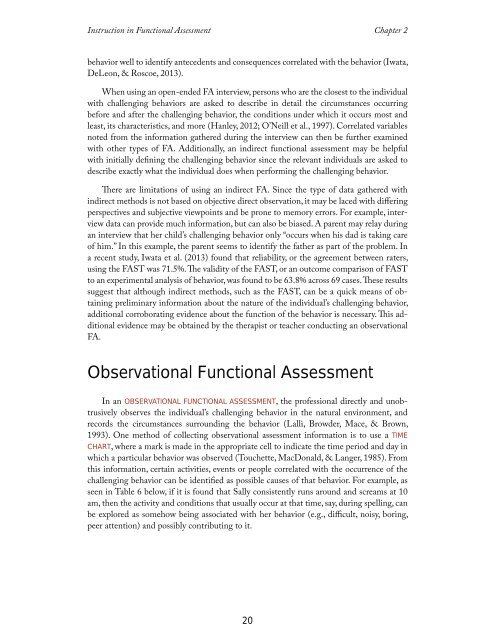Instruction in Functional Assessment, 2014a
Instruction in Functional Assessment, 2014a
Instruction in Functional Assessment, 2014a
Create successful ePaper yourself
Turn your PDF publications into a flip-book with our unique Google optimized e-Paper software.
<strong>Instruction</strong> <strong>in</strong> <strong>Functional</strong> <strong>Assessment</strong> Chapter 2<br />
behavior well to identify antecedents and consequences correlated with the behavior (Iwata,<br />
DeLeon, & Roscoe, 2013).<br />
When us<strong>in</strong>g an open-ended FA <strong>in</strong>terview, persons who are the closest to the <strong>in</strong>dividual<br />
with challeng<strong>in</strong>g behaviors are asked to describe <strong>in</strong> detail the circumstances occurr<strong>in</strong>g<br />
before and after the challeng<strong>in</strong>g behavior, the conditions under which it occurs most and<br />
least, its characteristics, and more (Hanley, 2012; O’Neill et al., 1997). Correlated variables<br />
noted from the <strong>in</strong>formation gathered dur<strong>in</strong>g the <strong>in</strong>terview can then be further exam<strong>in</strong>ed<br />
with other types of FA. Additionally, an <strong>in</strong>direct functional assessment may be helpful<br />
with <strong>in</strong>itially def<strong>in</strong><strong>in</strong>g the challeng<strong>in</strong>g behavior s<strong>in</strong>ce the relevant <strong>in</strong>dividuals are asked to<br />
describe exactly what the <strong>in</strong>dividual does when perform<strong>in</strong>g the challeng<strong>in</strong>g behavior.<br />
There are limitations of us<strong>in</strong>g an <strong>in</strong>direct FA. S<strong>in</strong>ce the type of data gathered with<br />
<strong>in</strong>direct methods is not based on objective direct observation, it may be laced with differ<strong>in</strong>g<br />
perspectives and subjective viewpo<strong>in</strong>ts and be prone to memory errors. For example, <strong>in</strong>terview<br />
data can provide much <strong>in</strong>formation, but can also be biased. A parent may relay dur<strong>in</strong>g<br />
an <strong>in</strong>terview that her child’s challeng<strong>in</strong>g behavior only “occurs when his dad is tak<strong>in</strong>g care<br />
of him.” In this example, the parent seems to identify the father as part of the problem. In<br />
a recent study, Iwata et al. (2013) found that reliability, or the agreement between raters,<br />
us<strong>in</strong>g the FAST was 71.5%. The validity of the FAST, or an outcome comparison of FAST<br />
to an experimental analysis of behavior, was found to be 63.8% across 69 cases. These results<br />
suggest that although <strong>in</strong>direct methods, such as the FAST, can be a quick means of obta<strong>in</strong><strong>in</strong>g<br />
prelim<strong>in</strong>ary <strong>in</strong>formation about the nature of the <strong>in</strong>dividual’s challeng<strong>in</strong>g behavior,<br />
additional corroborat<strong>in</strong>g evidence about the function of the behavior is necessary. This additional<br />
evidence may be obta<strong>in</strong>ed by the therapist or teacher conduct<strong>in</strong>g an observational<br />
FA.<br />
Observational <strong>Functional</strong> <strong>Assessment</strong><br />
In an OBSERVATIONAL FUNCTIONAL ASSESSMENT, the professional directly and unobtrusively<br />
observes the <strong>in</strong>dividual’s challeng<strong>in</strong>g behavior <strong>in</strong> the natural environment, and<br />
records the circumstances surround<strong>in</strong>g the behavior (Lalli, Browder, Mace, & Brown,<br />
1993). One method of collect<strong>in</strong>g observational assessment <strong>in</strong>formation is to use a TIME<br />
CHART, where a mark is made <strong>in</strong> the appropriate cell to <strong>in</strong>dicate the time period and day <strong>in</strong><br />
which a particular behavior was observed (Touchette, MacDonald, & Langer, 1985). From<br />
this <strong>in</strong>formation, certa<strong>in</strong> activities, events or people correlated with the occurrence of the<br />
challeng<strong>in</strong>g behavior can be identified as possible causes of that behavior. For example, as<br />
seen <strong>in</strong> Table 6 below, if it is found that Sally consistently runs around and screams at 10<br />
am, then the activity and conditions that usually occur at that time, say, dur<strong>in</strong>g spell<strong>in</strong>g, can<br />
be explored as somehow be<strong>in</strong>g associated with her behavior (e.g., difficult, noisy, bor<strong>in</strong>g,<br />
peer attention) and possibly contribut<strong>in</strong>g to it.<br />
20


















